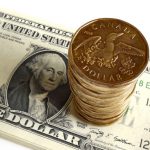 Yesterday’s trade saw USD/CAD within the range of 1.2751-1.2839. The pair closed at 1.2832, edging up 0.37% on a daily basis. It has been the 59th gain in the past 115 trading days and also a third consecutive one. The daily high has been an exact test of the high from June 7th. USD/CAD has gone down 1.93% so far in June, following a 4.31% surge in the prior month.
Yesterday’s trade saw USD/CAD within the range of 1.2751-1.2839. The pair closed at 1.2832, edging up 0.37% on a daily basis. It has been the 59th gain in the past 115 trading days and also a third consecutive one. The daily high has been an exact test of the high from June 7th. USD/CAD has gone down 1.93% so far in June, following a 4.31% surge in the prior month.
At 7:13 GMT today USD/CAD was inching up 0.07% on the day to trade at 1.2841. The pair touched a daily high at 1.2848 at 7:07 GMT, making an exact test of the daily R2 level, and a daily low at 1.2815 during the early phase of the Asian trading session.
Canadas dollar continued to retreat against its US counterpart, as crude oil futures tested lows unseen since June 2nd on Monday. Crude oil marked its 58th drop out of the past 126 trading days on June 13th. Oil for July delivery went down as low as $48.16 per barrel and closed at $48.40, plunging 1.37% compared to Friday’s close. As of 7:20 GMT today the commodity was losing 0.52% to trade at $48.15, after going down as low as $48.12 per barrel earlier.
On Tuesday USD/CAD trading may be influenced by the following macroeconomic reports as listed below.
Fundamentals
United States
Retail Sales
Retail sales in the United States probably rose for a second straight month in May, going up at a monthly rate of 0.3%, according to the median forecast by experts, following a 1.3% surge in April. The latter has been the fastest monthly increase since March 2015, supported by sales of automobiles.
Among the 13 major categories, 11 registered growth, 1 showed decline and 1 registered no growth in April. During the period, a decrease in sales was registered at building materials and garden equipment dealers (-1.0% month-over-month).
On the other hand, in March, retail sales went up motor vehicle and part dealers (up 3.2% month-over-month), at gasoline stations (2.2%), non-store retailers (2.1%), miscellaneous store retailers (1.5%), clothing stores (1%), food and beverages places (0.9%), health and personal care stores (0.9%), furniture and home furniture stores (0.7%), electronics and appliance stores (0.5%), food services and drinking places (0.3%) and sporting goods, hobby, book and music stores (0.2%), according to the report by the US Census Bureau.
Sales at in general merchandise stores remained unchanged in April from a month ago.
Annualized retail sales increased 3.0% in April, following a 1.7% climb in March.
US core retail sales, or retail sales ex autos, probably rose 0.4% in May compared to a month ago, following a 0.8% gain in April. If so, it would be a third consecutive month of increase. This indicator removes large ticket prices and historical seasonality of automobile sales.
A larger-than-expected rate of increase in both indexes would have a strong bullish effect on the US dollar. The official report is due out at 12:30 GMT.
Import and Export Prices
Prices of imported goods in the United States probably rose for a third consecutive month in May, going up at a monthly rate of 0.7%, according to market expectations. If so, this would be the steepest monthly increase since May 2015, when a revised down rate of 1.2% was reported. In April import prices were 0.3% higher from a month ago, as imported fuel prices went up 3.3%, while non-fuel prices (consumer goods, foods and beverages, feeds, capital goods) edged up 0.1%. In annual terms, import prices were 5.7% lower in April, which has been the 21st consecutive month of decline. Generally, higher import prices of goods suggest higher rates of consumer inflation.
Prices of exported goods from the United States probably increased 0.3% in May, according to market expectations. In April export prices rose 0.5% from a month ago, as non-agricultural export prices surged 0.5%, supported by higher costs for industrial supplies and materials and capital goods, while agricultural export prices went up 0.5%, supported by prices of soybeans. In annual terms, export prices slumped 5.0% in May, or for a 20th month in a row. Lower prices of exported goods generally bolster demand abroad, and as US trade accounts for 20% of international trade relations, this also tends to be dollar positive.
The Department of Labor is expected to release the official numbers at 12:30 GMT.
Daily, Weekly and Monthly Pivot Levels
By employing the Camarilla calculation method, the daily pivot levels for USD/CAD are presented as follows:
R1 – 1.2840
R2 – 1.2848
R3 (range resistance) – 1.2856
R4 (range breakout) – 1.2880
S1 – 1.2824
S2 – 1.2816
S3 (range support) – 1.2808
S4 (range breakout) – 1.2784
By using the traditional method of calculation, the weekly pivot levels for USD/CAD are presented as follows:
Central Pivot Point – 1.2807
R1 – 1.2962
R2 – 1.3140
R3 – 1.3295
S1 – 1.2629
S2 – 1.2474
S3 – 1.2296
In monthly terms, for USD/CAD we have the following pivots:
Central Pivot Point – 1.2914
R1 – 1.3317
R2 – 1.3646
R3 – 1.4102
S1 – 1.2638
S2 – 1.2182
S3 – 1.1906





